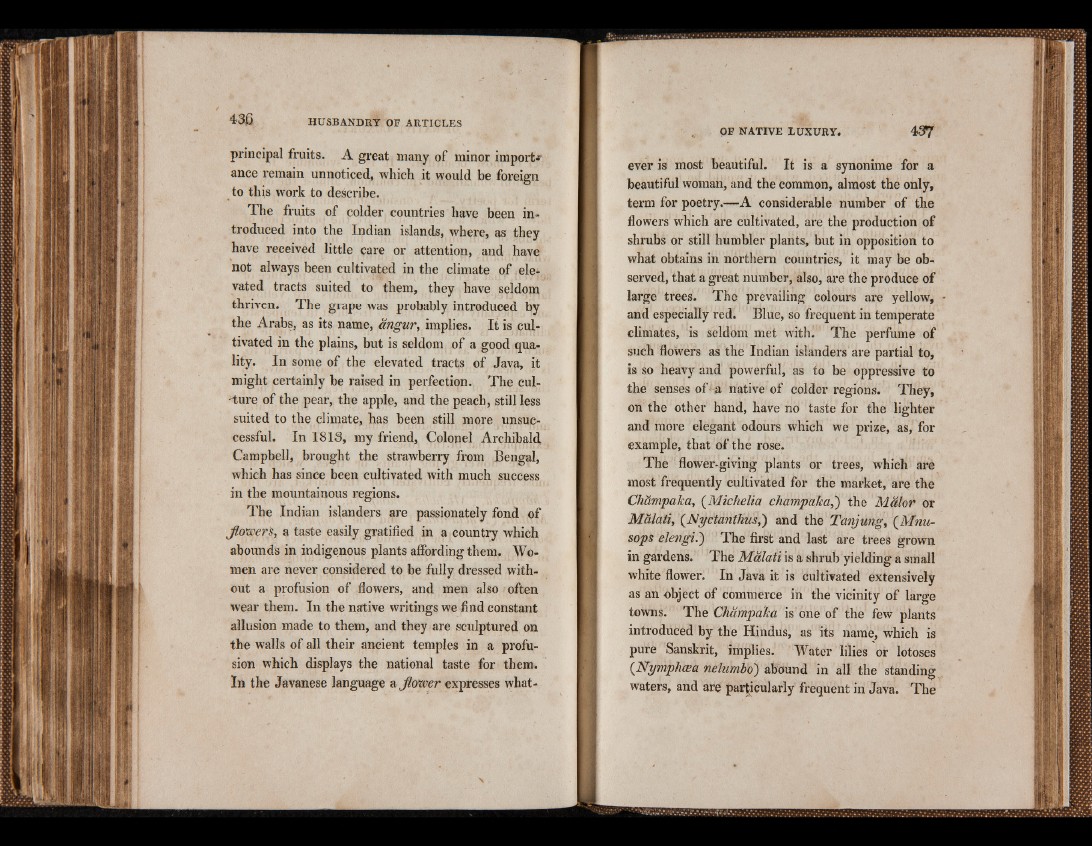
principal fruits. A great many of minor import*
ance remain unnoticed, which it would be foreign
to this work to describe.
The fruits of colder countries have been introduced
into the Indian islands, where, as they
have received little care or attention, and have
not always been cultivated in the climate of elevated
tracts suited to them, they have seldom
thriven. The grape was probably introduced by
the Arabs, as its name, angur, implies. It is cultivated
in the plains, but is seldom of a good quality.
In some of the elevated tracts of Java, it
might certainly be raised in perfection. The culture
of the pear, the apple, and the peach, still less
suited to the climate, has been still more unsuccessful.
In 1813, my friend, Colonel Archibald*
Campbell, brought the strawberry from Bengal,
which has since been cultivated with much success
in the mountainous regions.
The Indian islanders are passionately fond of
flowers, a taste easily gratified in a country which
abounds in indigenous plants affording them. Women
are never considered to be fully dressed without
a profusion of flowers, and men also often
wear them. In the native writings we find constant
allusion made to them, and they are sculptured on
the walls of all their ancient temples in a profusion
which displays the national taste for them.
In the Javanese language a flower expresses whatever
is most beautiful. It is a synonime for a
beautiful woman, and the common, almost the only,
term for poetry.—A considerable number of the
flowers which are cultivated, are the production of
shrubs or still humbler plants, but in opposition to
what obtains in northern countries, it may be observed,
that a great number, also, are the produce of
large trees. The prevailing colours are yellow,
and especially red. Blue, so frequent in temperate
climates, is seldom met with. The perfume of
such flowers as the Indian islanders are partial to,
is so heavy and powerful, as to be oppressive to
the senses of ¿a native of colder regions. They,
on the other hand, have no taste for the lighter
and more elegant odours which we prize, as, for
example, that of the rose.
The flower-giving plants or trees, which are
most frequently cultivated for the market, are the
Champa ka, (Michelia champajca,) the Malor or
Malati, (.Nyctanthus,) and the Tanjung, (Mnu-
sops elengi.) The first and last are trees grown
in gardens. The Malati is a shrub yielding a small
white flower. In Java it is cultivated extensively
as an object of commerce in the vicinity of large
towns. The Champaka is one of the few plants
introduced by the Hindus, as its name, which is
pure Sanskrit, implies. Water lilies or lotoses
(Nymphcea nelumbo) abound in all the standing
waters, and are particularly frequent in Java. The